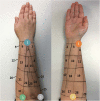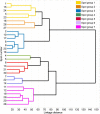Identification of forearm skin zones with similar muscle activation patterns during activities of daily living
- PMID: 30373606
- PMCID: PMC6206932
- DOI: 10.1186/s12984-018-0437-0
Identification of forearm skin zones with similar muscle activation patterns during activities of daily living
Abstract
Background: A deeper knowledge of the activity of the forearm muscles during activities of daily living (ADL) could help to better understand the role of those muscles and allow clinicians to treat motor dysfunctions more effectively and thus improve patients' ability to perform activities of daily living.
Methods: In this work, we recorded sEMG activity from 30 spots distributed over the skin of the whole forearm of six subjects during the performance of 21 representative simulated ADL from the Sollerman Hand Function Test. Functional principal component analysis and hierarchical cluster analysis (HCA) were used to identify forearm spots with similar muscle activation patterns.
Results: The best classification of spots with similar activity in simulated ADL consisted in seven muscular-anatomically coherent groups: (1) wrist flexion and ulnar deviation; (2) wrist flexion and radial deviation; (3) digit flexion; (4) thumb extension and abduction/adduction; (5) finger extension; (6) wrist extension and ulnar deviation; and (7) wrist extension and radial deviation.
Conclusion: The number of sEMG sensors could be reduced from 30 to 7 without losing any relevant information, using them as representative spots of the muscular activity of the forearm in simulated ADL. This may help to assess muscle function in rehabilitation while also simplifying the complexity of prosthesis control.
Keywords: Activities of daily living; Clustering analysis; Electrode placement; Electromyography; Forearm muscles; Functional principal component analysis; Myoelectric prostheses; Rehabilitation; Sollerman hand function test.
Conflict of interest statement
Competing interest
The authors declare that they have no competing interests.
Consent for publication
Not applicable.
Publisher’s Note
Springer Nature remains neutral with regard to jurisdictional claims in published maps and institutional affiliations.
Figures







Similar articles
-
Quantifying forearm muscle activity during wrist and finger movements by means of multi-channel electromyography.PLoS One. 2014 Oct 7;9(10):e109943. doi: 10.1371/journal.pone.0109943. eCollection 2014. PLoS One. 2014. PMID: 25289669 Free PMC article.
-
Coupling between wrist flexion-extension and radial-ulnar deviation.Clin Biomech (Bristol). 2005 Feb;20(2):177-83. doi: 10.1016/j.clinbiomech.2004.10.002. Clin Biomech (Bristol). 2005. PMID: 15621323 Clinical Trial.
-
Ranking hand movements for myoelectric pattern recognition considering forearm muscle structure.Med Biol Eng Comput. 2017 Aug;55(8):1507-1518. doi: 10.1007/s11517-016-1608-4. Epub 2017 Jan 4. Med Biol Eng Comput. 2017. PMID: 28054301
-
Decoding subtle forearm flexions using fractal features of surface electromyogram from single and multiple sensors.J Neuroeng Rehabil. 2010 Oct 21;7:53. doi: 10.1186/1743-0003-7-53. J Neuroeng Rehabil. 2010. PMID: 20964863 Free PMC article.
-
Assessment of hand function during activities of daily living using motion tracking cameras: A systematic review.Proc Inst Mech Eng H. 2019 Aug;233(8):764-783. doi: 10.1177/0954411919851302. Epub 2019 May 27. Proc Inst Mech Eng H. 2019. PMID: 31132926
Cited by
-
A Systematic Review of EMG Applications for the Characterization of Forearm and Hand Muscle Activity during Activities of Daily Living: Results, Challenges, and Open Issues.Sensors (Basel). 2021 Apr 26;21(9):3035. doi: 10.3390/s21093035. Sensors (Basel). 2021. PMID: 33925928 Free PMC article.
-
Electromyography and kinematics data of the hand in activities of daily living with special interest for ergonomics.Sci Data. 2023 Nov 20;10(1):814. doi: 10.1038/s41597-023-02723-w. Sci Data. 2023. PMID: 37985780 Free PMC article.
-
Deep learning and session-specific rapid recalibration for dynamic hand gesture recognition from EMG.Front Bioeng Biotechnol. 2022 Dec 15;10:1034672. doi: 10.3389/fbioe.2022.1034672. eCollection 2022. Front Bioeng Biotechnol. 2022. PMID: 36588953 Free PMC article.
-
A three-dimensional musculoskeletal model of the dog.Sci Rep. 2021 May 31;11(1):11335. doi: 10.1038/s41598-021-90058-0. Sci Rep. 2021. PMID: 34059703 Free PMC article.
-
A calibrated database of kinematics and EMG of the forearm and hand during activities of daily living.Sci Data. 2019 Nov 11;6(1):270. doi: 10.1038/s41597-019-0285-1. Sci Data. 2019. PMID: 31712685 Free PMC article.
References
-
- Yu H-L, Chase RA (Robert A, Strauch B. Atlas of hand anatomy and clinical implications. Mosby; 2004.
Publication types
MeSH terms
LinkOut - more resources
Full Text Sources

